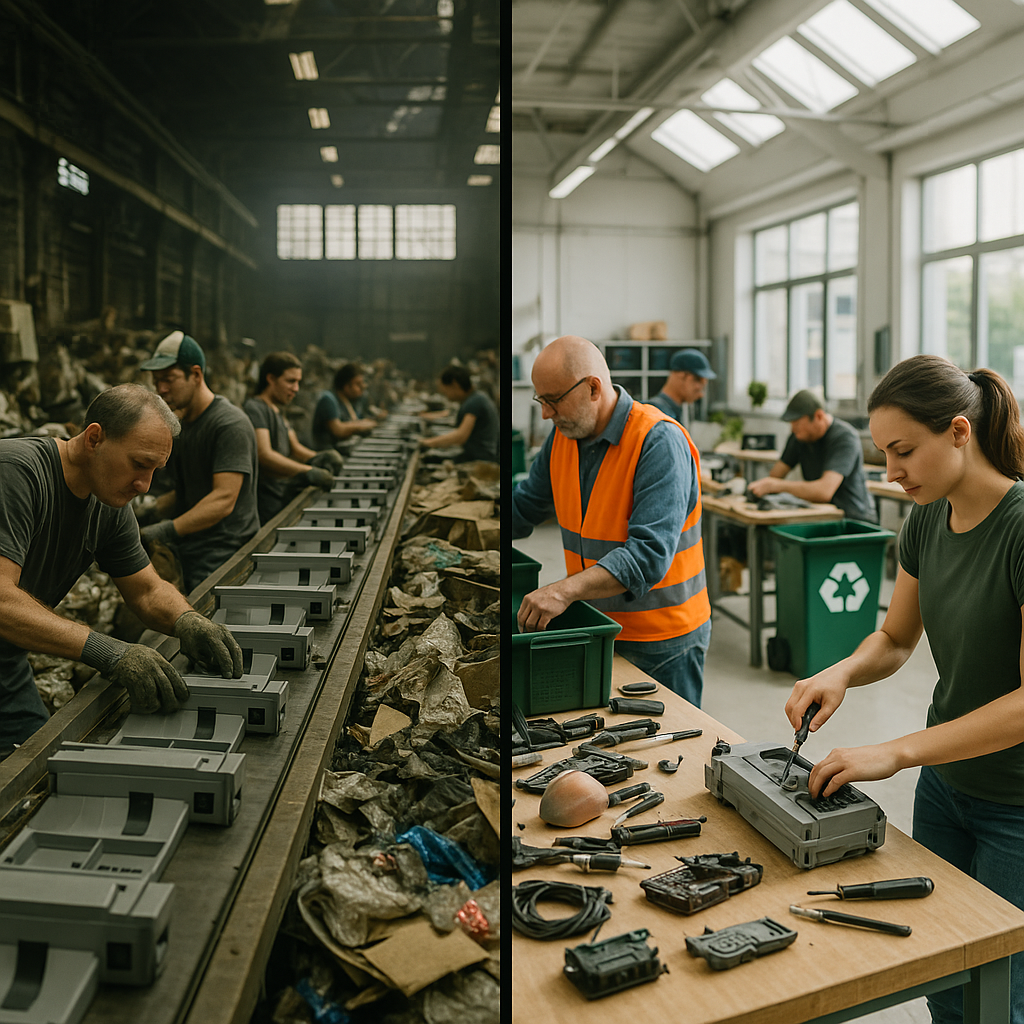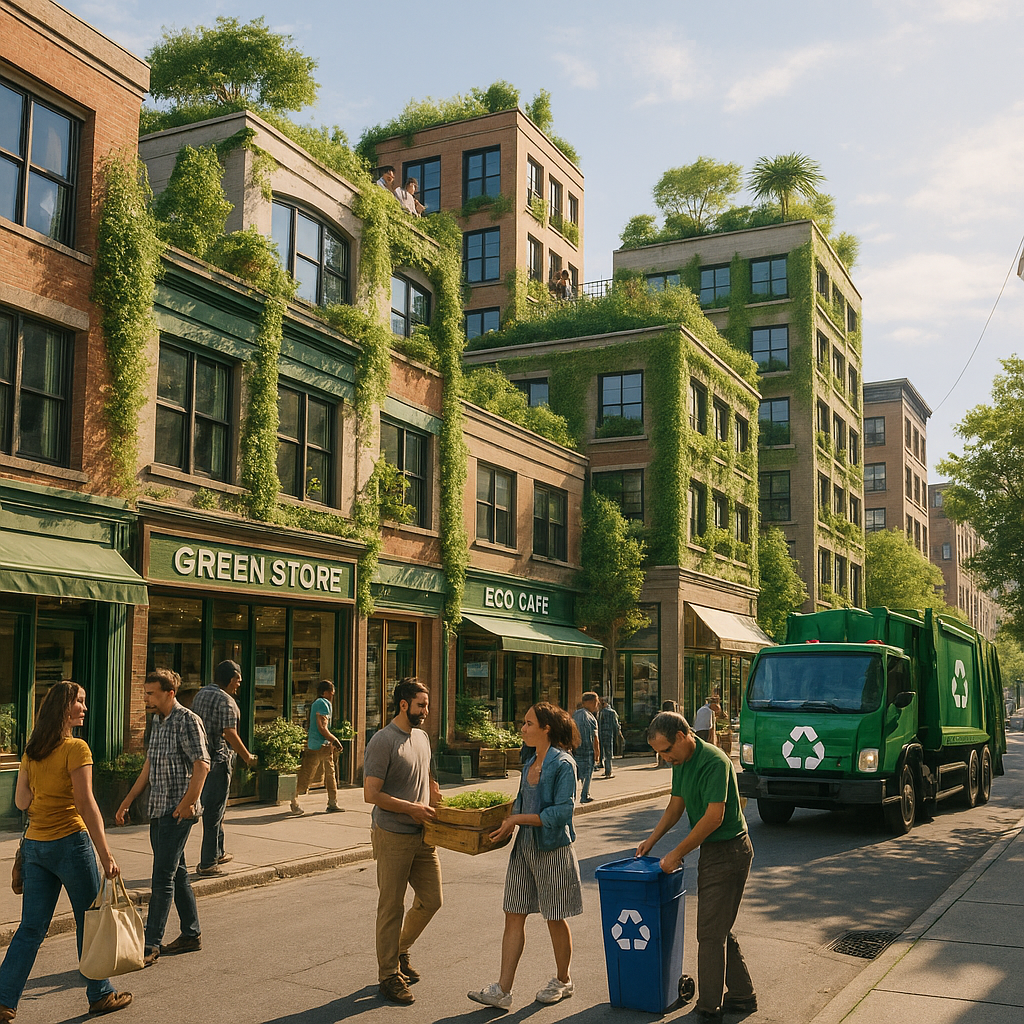5901 Botham Jean Blvd, Dallas, TX 75215
What Is the Circular Economy? Principles, Benefits, and How Businesses Can Adapt
August 20, 2025The circular economy offers an innovative approach to how we produce, consume, and manage resources. Unlike the traditional take-make-dispose model, the circular economy aims to keep materials in use for as long as possible, creating systems where waste is virtually eliminated and resources retain their value.
At its core, the circular economy involves sharing, leasing, reusing, repairing, refurbishing, and recycling materials and products. This extends product lifecycles while minimizing waste. When a product reaches the end of its life, its components are reused as valuable resources in new production cycles.
The importance of the circular economy is evident as global material consumption has risen by over 65% in the past two decades, placing unprecedented strain on resources. The circular model offers practical solutions to challenges such as resource depletion, waste management, and environmental degradation. By keeping materials in circulation, we reduce the need for virgin resource extraction while providing economic opportunities and environmental benefits.
How Does the Circular Economy Differ from the Linear Model?

The linear economy follows a straight path: resources are taken, products are made, used, and then discarded as waste. This ‘take-make-consume-throw away’ approach treats the planet’s resources as limitless. In contrast, the circular economy keeps materials in continuous cycles. The differences between these models extend beyond their names.
In the linear model, manufacturers extract raw materials to produce goods with little regard for their end-of-life impact. Companies primarily focus on efficiency and low costs, relying on abundant, accessible materials and energy without considering environmental impacts or resource scarcity.
The circular economy fundamentally differs by designing waste out of the system from the start. Products are crafted with their entire lifecycle in mind, considering what happens after their initial use. Materials flow in loops, preserving their value through reuse, repair, refurbishment, and recycling.
Resource Consumption Patterns
Linear economies impose significant environmental strain through intensive resource extraction. Virgin raw materials like timber, metals, petroleum, and minerals are continuously harvested to feed production. Once products reach their end of life, these valuable materials often end up in landfills or incinerators.
The circular model drastically reduces reliance on virgin resources. It prioritizes using materials already in circulation and designing products that can be easily disassembled and recycled. For example, companies like Apeel have developed plant-based coatings for fresh produce that eliminate the need for plastic packaging while extending shelf life, addressing both packaging and food waste.
When new materials are needed, the circular economy favors renewable or bio-based options that can safely return to natural systems. This approach disconnects economic growth from resource consumption, a necessary shift as resource scarcity increases.
Waste Management Approaches
Waste is an inevitable byproduct in linear systems. Products are often designed with planned obsolescence, meaning they’re intentionally created to fail or become outdated after a certain period. This drives more sales but generates significant waste.
The circular economy views waste as a design flaw. It embraces the principles of reduce, reuse, and recycle to keep materials in productive use. Products are designed to be durable, repairable, and recyclable. Companies maintain ownership of materials through product-as-service models or take-back programs.
Consider how some furniture manufacturers offer leasing programs instead of selling items outright. When customers no longer need the furniture, it is returned for refurbishment and redistribution to new users, extending product life cycles and preventing materials from being discarded.
Product Design Philosophy
Linear economy products prioritize low production costs and consumer convenience, often sacrificing durability. Single-use items exemplify this approach—designed for momentary use before disposal.
The circular model rejects this throwaway mindset. Products are designed for longevity, repairability, and recycling, using standardized components, modular designs, and ensuring easy disassembly.
Companies like Fairphone demonstrate this with smartphones built to last and designed for easy repair. Users can replace individual components as needed rather than discarding the entire device, extending the phone’s life and reducing electronic waste.
Economic Value Creation
In the linear economy, value stems from producing and selling as many products as possible, incentivizing material throughput optimization.
The circular economy creates value by keeping products and materials in use. Services like maintenance, repair, refurbishment, and recycling become profitable endeavors. New business models, including product-service systems, sharing platforms, and secondary marketplaces, emerge.
Clothing resale platforms have grown dramatically, creating economic value by extending the life of garments that would otherwise be discarded, representing a fundamental change in how businesses operate and generate profits.
The transition from linear to circular necessitates reimagining our economic system. While challenging, it offers significant opportunities for innovation, resilience, and sustainable growth within the planet’s boundaries.
| Factor | Linear Economy | Circular Economy |
|---|---|---|
| Resource Use | Extract and discard | Reuse and regenerate |
| Waste Management | Landfill and incineration | Recycling and remanufacturing |
| Business Model | Sell and dispose | Product-as-a-service and resale |
| Environmental Impact | High emissions and pollution | Reduced waste and lower carbon footprint |
| Economic Sustainability | Short-term gains, high costs | Long-term resilience, cost savings |
What Are the Key Benefits of a Circular Economy?
The circular economy model offers transformative benefits across environmental, economic, and social dimensions. Unlike the traditional linear ‘take-make-dispose’ approach, the circular economy creates a sustainable system where resources maintain their value for as long as possible. Here are the key advantages of this innovative economic model.
Environmental Benefits
The circular economy delivers significant environmental improvements by fundamentally changing how we use resources. By keeping materials in use through reuse, repair, and recycling, it substantially reduces waste and resource extraction, leading to several important environmental outcomes:
Resource conservation is a primary benefit, with circular practices potentially reducing demand for virgin materials by up to 32%. This preservation helps protect natural ecosystems and biodiversity that would otherwise be disrupted by resource extraction activities.
Carbon emissions decrease significantly with circular principles. Approximately 45% of global greenhouse gas emissions come from product manufacturing and use. Circular economy strategies could cut these emissions by up to 39% by reducing energy-intensive processes of raw material extraction and production.
Waste reduction is also a critical environmental advantage. The circular economy aims for zero waste, keeping materials in circulation rather than sending them to landfills. This drastically reduces pollution in our air, water, and soil while alleviating pressure on waste management systems.
Economic Advantages
The economic benefits of a circular economy extend beyond cost savings to create new opportunities for growth and innovation:
Cost reduction is substantial for businesses implementing circular practices. Companies can save approximately 25% on material costs by using recycled inputs. Additionally, circular practices could reduce material and waste disposal costs by as much as $640 billion by 2050.
Job creation is another compelling economic benefit. The circular economy fosters employment in repair, refurbishment, remanufacturing, and recycling sectors. Research suggests a transition to circularity could create 7 to 8 million new jobs globally, particularly in labor-intensive fields like repair services and reverse logistics.
New business opportunities emerge as companies develop innovative models based on circular principles. Product-as-a-service, leasing arrangements, refurbishment services, and resource recovery operations are gaining traction in the circular economy.
Supply chain resilience improves as businesses reduce dependence on virgin materials and global supply networks. Using recycled materials and establishing local resource loops make companies less vulnerable to resource scarcity, price volatility, and geopolitical tensions affecting resource availability.
| Economic Benefit | Description |
|---|---|
| Cost Savings | Companies can save on material costs by using recycled inputs and reduce waste disposal costs, potentially leading to $640 billion in savings by 2050. |
| Job Creation | The circular economy can create 7 to 8 million new jobs globally, particularly in repair and refurbishment sectors. |
| Business Opportunities | New models like product-as-a-service, leasing, and refurbishment create innovative revenue streams. |
| Supply Chain Resilience | Reduction in reliance on virgin materials and enhancement of local resource loops improve resilience against resource scarcity and price volatility. |
| Economic Growth | The circular economy supports new growth models and drives innovation by stimulating sustainable practices. |
Consumer Benefits
Consumers stand to gain significantly from the transition to a circular economy in several ways:
Product durability increases as manufacturers design items for longer lifespans, easier repair, and eventual recycling. This shift away from planned obsolescence means consumers enjoy products that last longer and perform better over time.
Cost savings accumulate for consumers through access to more durable products, repair options, and alternative consumption models like leasing or sharing. The circular economy also promises increased disposable income through practices such as buying used items or participating in product service systems rather than traditional ownership.
Greater product choice becomes available as companies innovate to meet circular requirements. From refurbished electronics to upcycled fashion, consumers gain access to a wider range of sustainable options at various price points.
Innovation and Competitiveness
The circular economy drives innovation across multiple sectors by necessitating new approaches to design, production, and business models:
Product design innovation flourishes as companies rethink how items are created, used, and eventually recycled. The circular economy encourages modular design, material selection for recyclability, and designs that facilitate repair—with more than 80% of a product’s environmental impact determined during the design phase.
Manufacturing processes evolve to accommodate recycled materials, minimize waste, and reduce energy consumption. Companies implementing circular principles often develop proprietary technologies and methods that enhance their competitive position.
Service innovation expands as businesses move beyond selling products to providing comprehensive solutions. Companies like IKEA with its furniture take-back program and Renault with its automotive parts remanufacturing exemplify how established businesses can transform their operations around circular principles.
Social Benefits
The social dimension of the circular economy creates positive impacts for communities and individuals:
Community development strengthens through local repair initiatives, sharing platforms, and recycling programs. These activities build social connections while addressing environmental challenges at the community level.
Quality of life improves as pollution decreases and resource management becomes more sustainable. The reduction in waste and environmental degradation leads to healthier living conditions, particularly in urban areas.
Skills development accelerates as the circular economy demands new capabilities in repair, refurbishment, recycling, and sustainable design. This offers opportunities for training and education in emerging green skills.
The circular economy represents more than an environmental initiative—it is a comprehensive approach to creating a resilient, sustainable economic system that benefits businesses, consumers, communities, and the planet. By redesigning our relationship with resources and waste, we can achieve significant environmental protection while generating economic growth and improving social well-being.
How Can Businesses Implement Circular Economy Principles?

Adopting circular economy principles provides businesses with a robust framework for reducing waste, conserving resources, and building resilience. Companies across various industries are finding that circular approaches benefit not just the environment, but also create new value streams and competitive edges. Here are practical strategies businesses can implement to embrace circularity.
Design Products for Longevity and Repairability
Sustainable product design is foundational to circular business models. Companies can create products that last longer and remain in use through approaches like using durable materials, developing modular components for easy repair, and standardizing parts to simplify maintenance.
Patagonia exemplifies this approach through its Worn Wear program, encouraging customers to repair and reuse garments rather than discard them. The company offers repair services for damaged clothing and a trade-in option for store credit on used Patagonia items. This initiative successfully extends product lifespans while minimizing waste.
Similarly, IKEA has take-back programs that allow customers to return furniture for repurposing or recycling. The company also promotes product reuse and sustainable shopping habits through rental options and refurbished furniture sales.
Implement Circular Business Models
Beyond product design, businesses can adopt new models prioritizing access over ownership. Product-as-a-service offerings, where customers pay for performance rather than buying physical goods, help keep materials circulating longer.
For example, Dutch company MUD Jeans allows customers to lease jeans for around €10 monthly instead of purchasing them. When customers return old pairs, MUD recycles the denim into new jeans, creating a closed material loop. This approach reduces waste while offering consumers an affordable alternative to purchasing items they rarely wear.
Additionally, some businesses are establishing secondary marketplaces for their products. These platforms extend product lifecycles by connecting buyers with used items that might otherwise be discarded. This strategy is particularly effective for durable goods that retain functionality and value over time.
Transform Supply Chains and Resource Management
Supply chain sustainability is a crucial aspect of circular business practices. Companies should audit their supply chains to identify areas practicing sustainability and opportunities for improvement.
Resource-efficient manufacturing reduces waste and emissions while lowering production costs. Apple has made significant progress here, using 100% recycled aluminum and rare earth metals in its MacBook Air production. This approach protects the environment while extending the economic viability of resources through more efficient use.
Businesses can also partner with suppliers committed to sustainable practices. Establishing environmental standards for partners enables companies to create a ripple effect within their industries, encouraging wider adoption of circular principles.
Invest in Regenerative Technologies
True circularity goes beyond reducing negative impacts to actively restoring natural systems. Companies can invest in technologies and practices that rebuild environmental health and biodiversity.
Interface, a flooring company, demonstrates strong commitment to sustainability and circular economy principles through its closed-loop manufacturing process. The company produces carpet tiles using recycled materials and collects used tiles for recycling into new products. This approach reduces waste and fosters a circular economy.
Similarly, companies like HP have been incorporating circular practices for nearly two decades. Recently, HP launched the world’s first monitor and PC made from ocean-bound plastics, advancing its goal of becoming net-zero by 2040 using 100% renewable energy.
Measure and Evaluate Progress
Clear sustainability metrics help businesses track progress toward circular goals. Regular reporting validates efforts and provides opportunities to share successes with stakeholders, consumers, and employees.
Unilever exemplifies this by setting concrete targets and measuring progress. With a pledge to reduce packaging waste by 2025, the company has established recycling programs to increase education and recycling rates. Such clear goals and transparent reporting demonstrate commitment while offering a roadmap for continuous improvement.
Businesses should also be prepared to adjust strategies based on new research, evolving business interests, and emerging opportunities. This adaptability allows companies to refine their approaches while maintaining momentum toward circular objectives.
Engage Employees and Build Partnerships
Employee engagement is vital for successful sustainability initiatives. Companies should clearly communicate goals, processes, and expectations to ensure team alignment. In-office programs like communal reusable coffee mugs, recycling stations, and sustainability training help build a culture of environmental responsibility.
External partnerships also strengthen circular efforts. Businesses can collaborate with environmental organizations, industry associations, and even competitors to develop shared solutions. These collaborations often lead to innovations that individual companies couldn’t achieve alone.
Accenture demonstrates this approach through partnerships with organizations like Mastercard, Amazon Web Services, and Mercy Corps to advance circular supply chain capabilities. These collaborations enhance financial inclusion, promote sustainable practices, and empower consumers while helping clients achieve corporate sustainability goals.
By implementing these strategies, businesses can transform their operations to eliminate waste, circulate materials at their highest value, and regenerate natural systems. The circular economy offers a blueprint for companies seeking to build resilience, create new value, and contribute to environmental solutions.
Conclusion: The Future of the Circular Economy

The circular economy represents a crucial shift away from the unsustainable take-make-waste model toward a regenerative system that maximizes resource value. As global resource extraction continues to exceed the Earth’s capacity to regenerate, this transition has become not just advantageous but essential for our collective future.
The evidence is compelling: a circular economy could unlock $4.5 trillion in economic growth while reducing global greenhouse gas emissions by up to 39%. By creating new jobs in recycling and remanufacturing and enhancing resilience in critical supply chains for renewable energy technologies, circular principles offer practical solutions to pressing environmental and economic challenges. The growing adoption of circular practices by governments, businesses, and communities globally shows that this transition is already in progress, though significant technological, policy, and economic barriers remain.
For businesses and municipalities seeking to implement effective waste management strategies aligned with circular economy principles, contact Okon Recycling at 214-717-4083.
